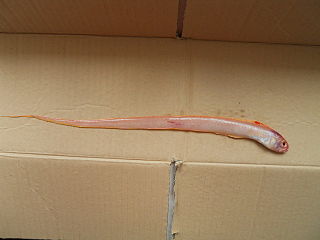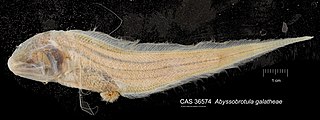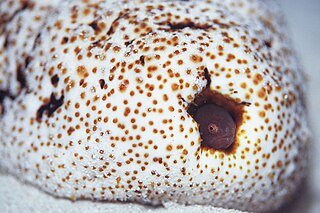
Sea cucumbers are echinoderms from the class Holothuroidea. They are marine animals with a leathery skin and an elongated body containing a single, branched gonad. They are found on the sea floor worldwide. The number of known holothurian species worldwide is about 1,786, with the greatest number being in the Asia-Pacific region. Many of these are gathered for human consumption and some species are cultivated in aquaculture systems. The harvested product is variously referred to as trepang, namako, bêche-de-mer, or balate. Sea cucumbers serve a useful role in the marine ecosystem as they help recycle nutrients, breaking down detritus and other organic matter, after which bacteria can continue the decomposition process.
Pearlfish are marine fish in the ray-finned fish family Carapidae. Pearlfishes inhabit the tropical waters of the Atlantic, Indian, and Pacific Oceans at depths to 2,000 m (6,600 ft), along oceanic shelves and slopes. They are slender, elongated fish with no scales, translucent bodies, and dorsal fin rays which are shorter than their anal fin rays. Adults of most species live symbiotically inside various invertebrate hosts, and some live parasitically inside sea cucumbers. The larvae are free living.

The bandfishes, family Cepolidae, are 23 species of marine ray-finned fishes, They are native to the East Atlantic and Indo-Pacific wherethey dig burrows in sandy or muddy seabeds and eat zooplankton.
This glossary of ichthyology is a list of definitions of terms and concepts used in ichthyology, the study of fishes.

The grey triggerfish, or gray triggerfish, is a species of ray-finned fish in the triggerfish family. The species is native to shallow parts of the western Atlantic from Nova Scotia to Argentina and also the eastern Atlantic, the Mediterranean Sea and off Angola on the west coast of Africa.

Scotoplanes is a genus of deep-sea sea cucumbers of the family Elpidiidae. Its species are commonly known as sea pigs.

Culcita novaeguineae is a species of starfish. It has short arms and an inflated appearance and resembles a pentagonal pincushion. It is variable in colour and can be found in tropical warm waters in the Indo-Pacific.

Thelenota ananas, also known as pineapple sea cucumber, oloturia ananas, tripang, prickly skin cucumber, pointed teat sea cucumber, armoured sea cucumber, giant sea cucumber, sand fish or prickly redfish, is a species of sea cucumber found in tropical Indo-Pacific waters from the Red Sea and East Africa to Hawaii and Polynesia.

Abyssobrotula galatheae is a species of cusk eel in the family Ophidiidae. It is the deepest-living fish known; one specimen, trawled from a depth of 8,370 m (27,460 ft) in the Puerto Rico Trench in 1970, holds the record for the deepest fish ever captured. Although generally recognized, some have suggested that the record-breaking individual might have been caught with a non-closing net and therefore perhaps caught shallower.
The worm pearlfish is an eel-like fish in the family Carapidae.
Gobioclinus gobio is a strictly marine ray finned fish, also called Gobioclinus gobio. Its common name is the palehead blenny, and is sometimes referred to as the goggle-eye blenny. It can be identified by its greenish top, red belly, and multicolored banding. L. gobio is a benthic organism with a wide range, taking up residence in a number of coastal environments from Florida to Brazil. This means the fish can live in equatorial, subtropical, and tropical climatic zones. It is native to coastal areas of the Caribbean. Its diet consists mainly of different molluscs and echinoderms.

Holothuria scabra, or sandfish, is a species of sea cucumber in the family Holothuriidae. It was placed in the subgenus Metriatyla by Rowe in 1969 and is the type species of the subgenus. Sandfish are harvested and processed into "beche-de-mer" and eaten in China and other Pacific coastal communities.

Bohadschia argus, the leopard sea cucumber, leopardfish, or tigerfish, is a species of marine invertebrate in the family Holothuriidae.

Lissocarcinus orbicularis, common names sea cucumber crab, red-spotted white crab, and harlequin crab is a species of crab in the family Portunidae. This species gains one of its names from its close-knit relationship with holothuroids, the sea cucumbers. L. orbicularis should not be confused with L. laevis, a similar species of swimming crab, or Camposcia retusa, both of which are also commonly referred to as the harlequin crab. L. orbicularis displays numerous morphological and social adaptations for feeding and has a large distribution throughout the Indo-West Pacific.

Carapus is a genus of pearlfishes, with these currently recognized species:

The pinhead pearlfish, Encheliophis boraborensis, is a species of slender, ray-finned fish in the family Carapidae found in the tropical Indo-Pacific Ocean; it normally lives inside the body cavity of a sea cucumber such as the pineapple sea cucumber or the leopard sea cucumber.
The silver pearlfish, Encheliophis homei, is a species of eel-like fish in the family Carapidae. This pearlfish lives inside the coelom of sea cucumbers such as Bohadschia argus, Thelenota ananas , and Stichopus chloronotus. It is native to tropical and subtropical parts of the Indo-Pacific Ocean.

The Atlantic batfish is a species of fish in the family Ogcocephalidae. It is found in deep water in the Atlantic Ocean where it lives on the seabed, feeding on small invertebrates.

Carapus acus is a species of bony fish in the family Carapidae, the pearlfishes, and is native to the Mediterranean Sea and the Atlantic Ocean. It lives as a commensal in association with a sea cucumber, spending the day inside its host and emerging at night to feed.

Parastichopus regalis, also known as the royal sea cucumber, is a species of sea cucumber in the family Stichopodidae.













